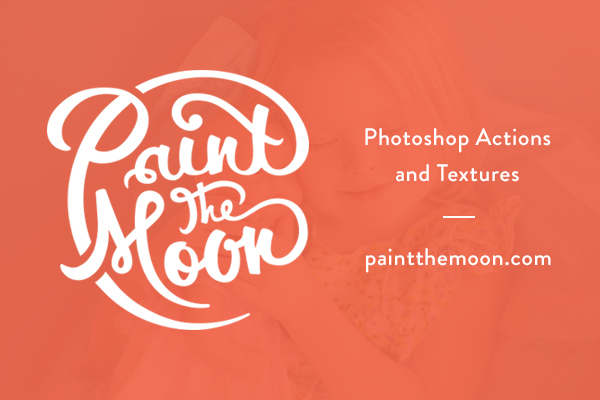
Using White (Negative) Space in Photography – Give Me Some Space! – Photoshop Actions

Did you know that what is in your photos is almost as important as what is NOT in your photos? White space (also known as negative or open space) is the space between or surrounding subjects in a composition … the space that does not compete with the subject for your attention. It’s a good thing! 🙂 It’s a vital piece of the puzzle in most types of design, whether it’s graphic design, interior design, landscape design, web design as well as photography. We want to give the eye some place to “rest” and help frame the subject.
Negative space can give an image a totally different feel from one taken with more of the subject or other elements filling up the frame. Having ample white space has the benefit of adding interest to the photo since it is a way to aid in emphasizing your subject. It can also help tell a story better or evoke stronger emotions depending on how it is used. Before I go on I should probably note that I like the term white or open space better than negative space … because negative sounds, well, negative – LOL! And I’m a happy photographer! 🙂
Even seasoned pros can be helped by slowing down and trying to think about the areas surrounding your subject in a more thoughtful manner … noticing how open space can anchor your subject, how it can create lines and a more dynamic composition, how it can balance your composition and how it draws the eye right to your subject. It can also be used to create a more playful and fun approach in your composition. I happen to love quirky portraits where the subject is peeking up from one side of the frame and all that wide open space just underline just how important that subject really is … kind of like a big spotlight but in a very subtle way.
Here are a few examples of how I’ve personally used white space in compositions.

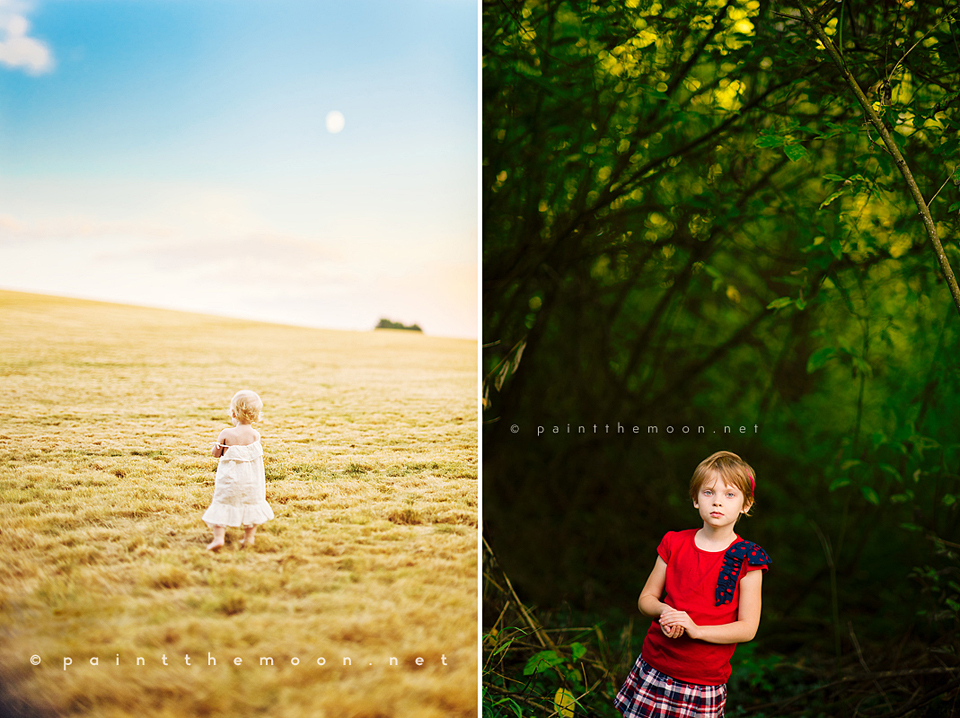
For those who have asked, the image above left was taken with a 45mm tilt-shift lens. 🙂

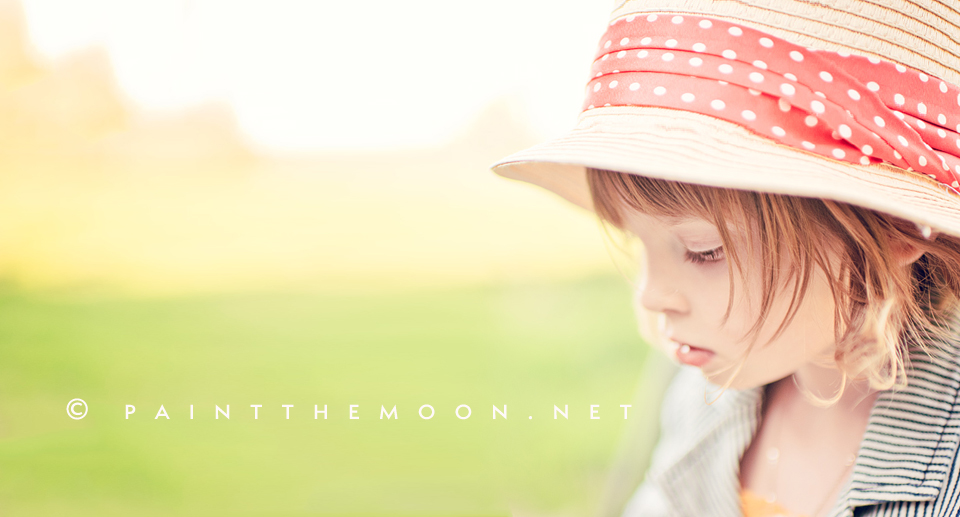
When thoughtfully composed, white space can play a large part in evoking emotion in the viewer. In this image below the white space is the sky she is looking into and gives the viewer quite a sense of mystery and hopefully evokes some kind of emotion when the viewer sees the sense of awe on her face.
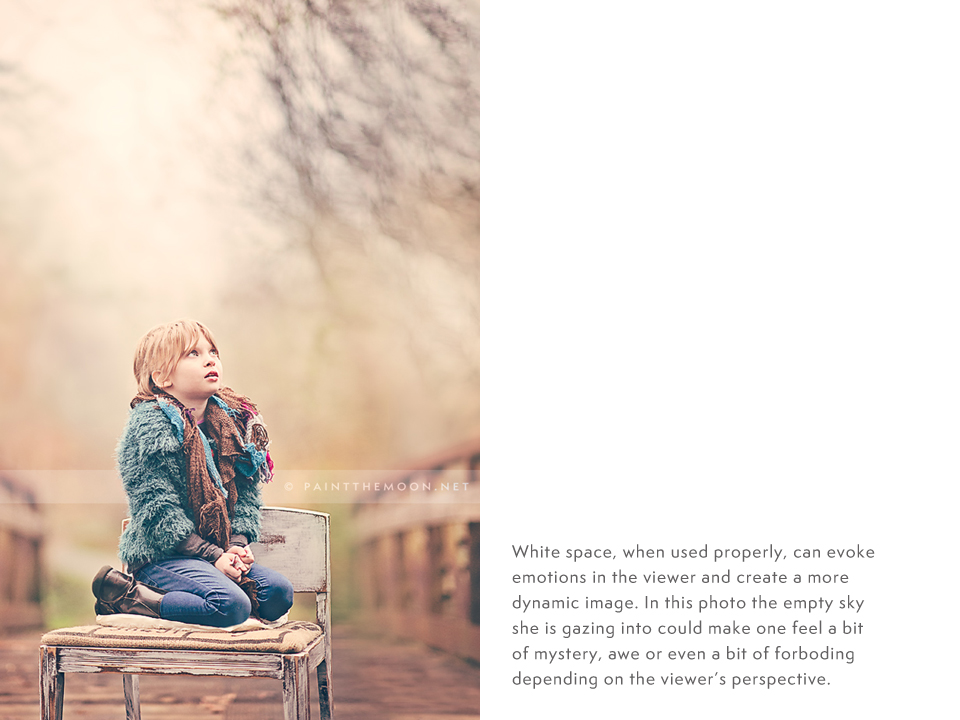
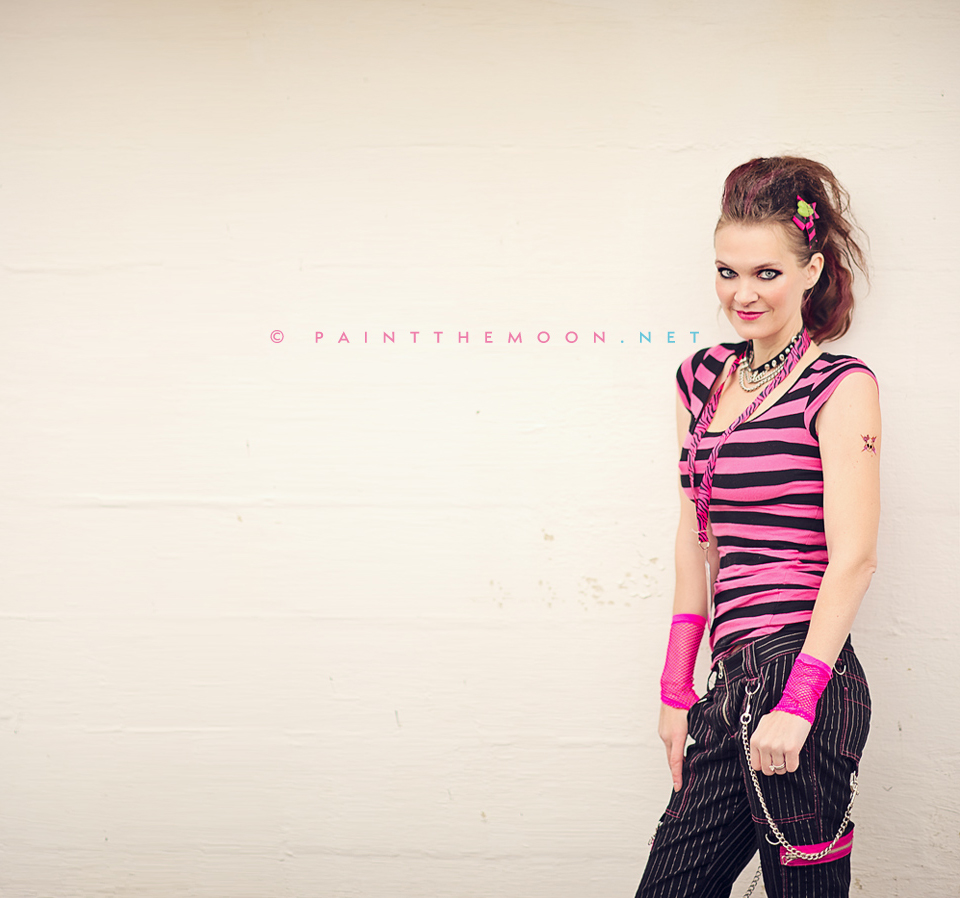
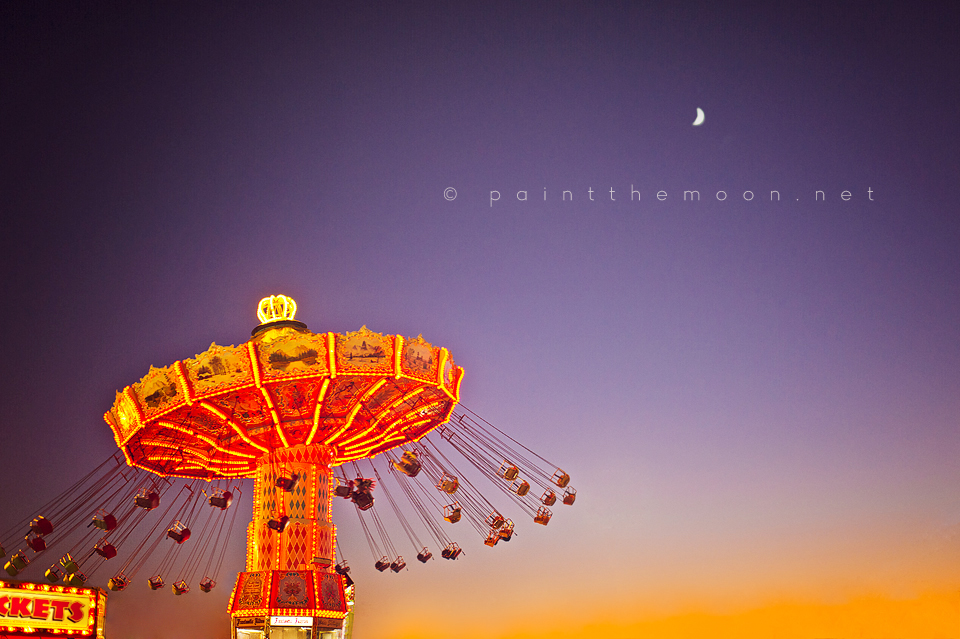


Some points to keep in mind when shooting white space in portraits …
Watch their eyes and the direction of their body.
Always be watching where your subject’s eyes are directed and compose accordingly. You want your subject to be looking into the frame so that they are gazing into the white space your composition has created. It makes a viewer uncomfortable if your subject sight line is falling out of the frame (if they are looking towards the edge of the image instead of into it). When the subject is looking into the white space it lets the viewers eyes roam around the image and gives a sense of comfort, however, if they follow the subject’s eye out to land directly at the edge of the frame it puts one on edge (even though they may not know why).
White space can be many “colors.”
White space can be made up of different elements, just as long as it’s “quiet” and gives the eye a rest. It can be a background with creamy bokeh from shooting with a wide aperture or a background void of much detail or texture (walls, sky, water, etc). Move around and shoot from different perspectives to find the best composition and white space that complements and frames your subject the best.
Follow the rules.
Think of a tic tac toe board and where those lines intersect … the rule of thirds recommend placing your subject at one of those intersections. This creates balance and interest in your composition. If you place your subject at one side or the other (or for vertical images, on the top or lower half) of the frame, the viewer’s eye will be able to travel around the image, following the subject’s line of sight (since you’re composing as discussed in tip one with the subject’s eyes gazing into the frame). See below for a diagram of the Rule of Thirds and the circled areas where you want to have your subject in for this type of composition. For a close up portrait, try to have the eyes in one of those intersections shown. Another fabulous rule to compose an image by (as well as paintings or most other type of art or designs) is by using the Golden Mean (or Golden Section, Golden Spiral, Golden Ratio). I won’t get into to those here as they’re a bit more in depth than the rule of thirds, but it’s a great way to draw the viewers eye into the subject.
Also note that I use the word “rule” here simply because that is it’s common name. I happen to believe that while the rule of thirds is almost always a pleasing way to compose your image, it is most definitely not the only way. Which leads me to our next point …
Breaking the rules. Because symmetry is beautiful too.
And then sometimes, if you know why you are doing it and have a purpose or vision in mind when shooting, breaking the rule of thirds can be a very good thing too. I purposely composed this shot with my tiny girl smack dab in the center … usually a no no and a recipe for a drab looking composition for some portraits. All that white space surrounding her makes me almost feel the awe that she must have been feeling in that wide, open and beautiful space. Her centered little body seems to make it feel even more dynamic to me here and a perhaps touch more artful. Of course, that’s totally open to interpretation and others may hate it … but I believe it just fits my own style.
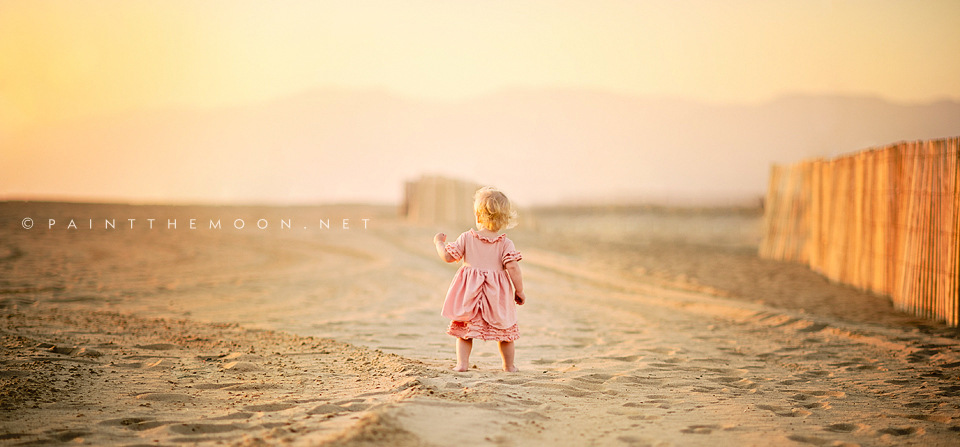
Do try not to get so caught up in the “rules” so that you lose your creative freedom or your compositions become static and repetitive. Here is a helpful post all about shooting from different perspectives to help you start thinking outside the box a little.
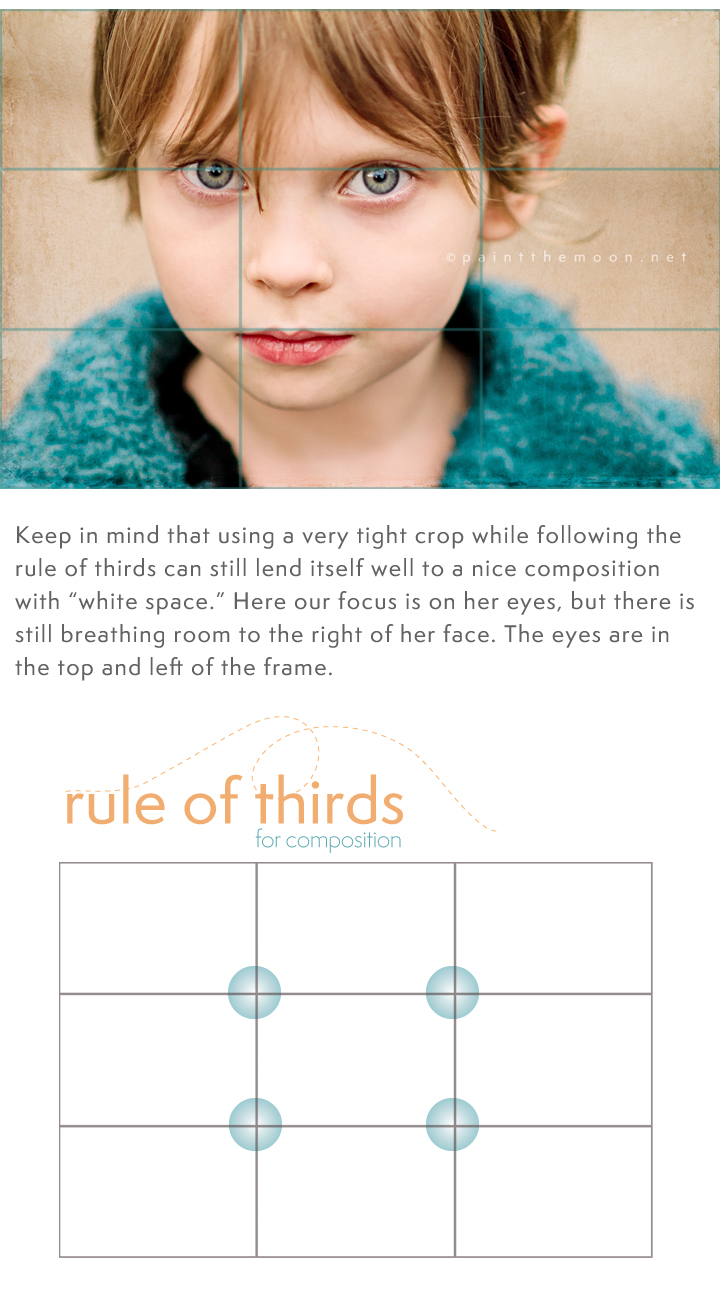

For the example below I’m using an image cropped in post processing simply for demonstration’s sake … the original was cropped in camera (meaning I didn’t crop anything off the original while editing). I try to compose all my photos in camera … so, I shoot it the way I want the final composition to end up (with just a bit of “breathing room” around the edges to allow for prints at different aspect ratios). It can be more challenging to see the final composition through your viewfinder versus thinking, I’ll just crop it the way it looks best later. I think in camera cropping is something every photographer should at least practice, if not strive to do most of the time. To be making the choice about what to include and what not to include in your images in order to create the best composition while actually shooting is a wonderful skill to have.
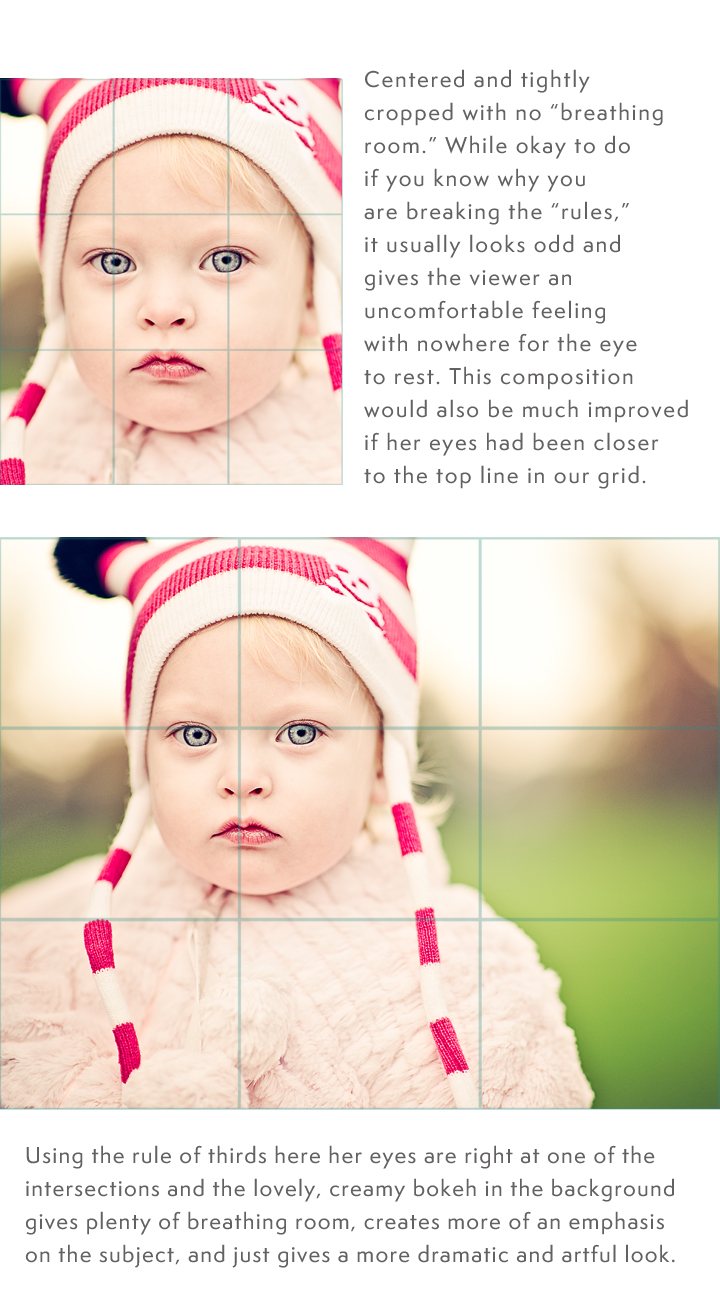
It can be an exercise in creativity to go out and shoot while carefully considering every element in the frame and how they frame your subject … are they helping or hurting the composition’s strength? It’s also a fun exercise to go back through older photos and using the rule of thirds, re-crop just for the sake of seeing how different compositions can give a photo a completely different feel. I hope you found this helpful and I encourage you to go out and shoot with a mindful eye on your white space as well as your composition. Have a beautiful and creative day!!
Tags: composition photography, creativity, negative space photography, Photography Articles, Photoshop Actions for Photographers, rule of thirds photography, white space
Loved this article! I try so hard to pay attention to the rule of thirds, but find myself forgetting allll the time. lOl Enjoying your comments about white space as well. Thank you so much for sharing your talent and wisdom!
Well done for all your time in composing this beautiful post. Thanks Annie. PS on the 52, can we post more than one image per week, sorry can’t remember?
Very helpful and creative info as always. Thanks!
I really needed to read this! Wow! You have no idea how much this helps me. While reading it, I had a million ideas floating through my head. Now that I have some sort of direction, I know where I need to go!
Your articles are so informative. I have read much about the rule of two thirds lately, but I think your article and examples really say it all. I LOVE your work, by the way. I am new at Photoshop and just upgraded from Elements to CS5 and LR3 and I must say, for the moment, I am totally lost. I will definitely come back to your site, as time allows, to brush up! Thanks for your time and your daughters are beautiful – kind of hard to have poor outcome with those two!!!
Awesome article. Thanks for catering to the newbies on this one, it was very easy to understand, and will make putting into practice that much easier!
Loved this article. Very informative and well written. Thank you for all of your helpful suggestions.
Thanks for the reminder. Love all the shots. I too get in a hurry and forget the basic rule of thirds then have to recrop in PS.
I did find this very helpful. I enjoy every article you publish!
This is perfect timing as we are covering these topics in my photography class! Great and helpful information and the overlay will be such a help! Thank you so much 🙂
GREAT article. It challenges me to be more mindful of these concepts while shooting. You are an amazing photographer. Thank you for sharing your knowledge and wisdom.
Thanks so much Annie!! I have been looking for some good explanations to help me and this is by far the best :)!!
Great easy to read article – thanks so much! Where do you find the time!!!
Wonderful article Annie. Love the information and great writing!! Appreciate it so much ?
….oh and love revisiting some of my favorites of yours!!
This is a GREAT article Annie. I give it a ten on a scale of one to ten. Such great information & examples. Thanks so much for writing & sharing this!
Great post. Love all the photos! 🙂
From a new “follower”. Thank you for this lesson. Im not a photographer YET, I am an artist and have a few friends that are photographers. I am thinking of learning more about photoshop and “layers” etc to help my friends. Its quite overwhelming to be given 55 incredible shots someone took of your child that havent been edited etc. To know that by adding a little this and a little that, cropping here and there it could totally change the photo.Great shots and well written instructions.thank you!
These pictures are so gorgeous you do amazing work- I love the outfits!
Thanks for the post. Very informative!!!
What a great article. I love your tips. I must say that 3/52 has been very educational for me. Its reasons like this that I am so glad that I joined your group! Thanks Annie.
Thanks!
Awesome, mini tutorial!! Thank you, Ms. Annie. I hope I can get caught up this week:)
Lovely pictures and awesome photography.